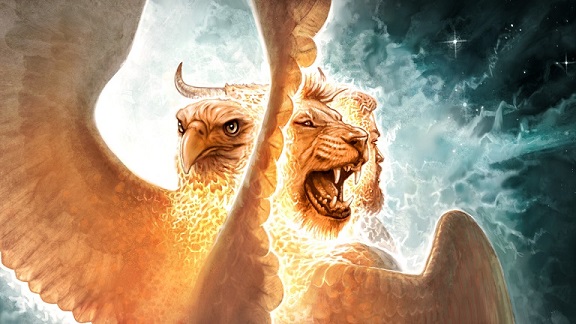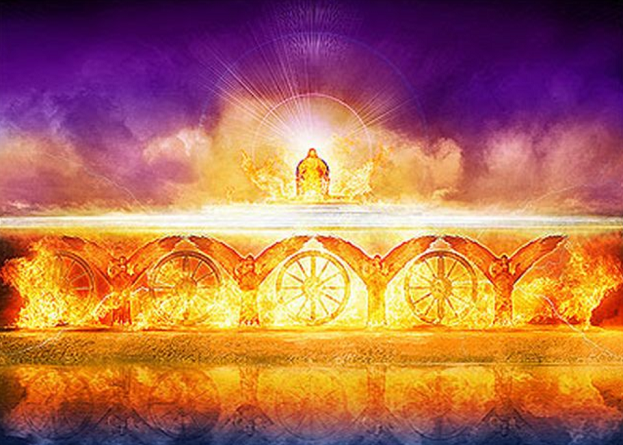This article is part of a series on Old Testament Christophanies. For important background information, see An Introduction to Old Testament Christophanies–with Justin Martyr.
Ezekiel’s vision of the Lord in Ezekiel 1 is one of the best-known theophanies in the Bible. The description is not only vivid but at times can come off as rather bizarre. Ezekiel first described a storm, four cherubim, wheels with eyes, and a crystal expanse before describing a figure who looked like a man sitting on a celestial throne.
After the Judeans had been taken captive in Babylon in 597 BC, Ezekiel the priest, son of Buzi, found himself among the exiles who settled near the river Chebar (a large navigable canal that routed water from the Euphrates). It was there, where in 593 BC, Ezekiel saw visions of God. The word of Yahweh came expressly to Ezekiel, and the hand of Yahweh was upon him (vv. 1–3). The word of Yahweh was overwhelming and undeniably real. And the hand of Yahweh would strengthen Ezekiel to do the work he would soon be called to. The vision came in the “thirtieth year” (v. 1), which is likely in reference to Ezekiel’s thirtieth year.[1] He was a priest, and priests began their service at the age of thirty (e.g., Num 4:3; 1 Chr 23:3). The vision specifically came on the “fifth day of the fourth month” (v. 1), which is equivalent to July 31. (I cannot help but think that the vision came to Ezekiel on his thirtieth birthday.) Ezekiel wouldn’t get to perform the priestly functions that his ancestors had for generations. But like with Isaiah, he was about to become a prophet after having an amazing encounter with the Son of God.
Ezekiel beheld a “windstorm” or “whirlwind” (Heb. seʹarah) coming from the north. It was a great cloud with fire flashing back and forth, and around it was a bright light. Within the fire was something that looked like glowing metal (v. 4). Like with Elisha and Job, Ezekiel was confronted with a Shekinah storm. According to the Targum, Ezekiel saw a “vision of the glory of the Shekinah of the Lord.”[2] The storm surrounded the Lord’s very presence. Yahweh coming in a storm from the north is reminiscent of when He appeared to Job in a whirlwind immediately after Elihu had described God coming from the north, surrounded by awesome majesty (Job 37:21—38:1).

In the midst of the cloud were what appeared to be four living beings, each having a general human form. The beings each had four faces: the face of a man on the front of the head, the face of a lion on the right side, the face of a bull on the left side, and the face of an eagle on the back. Each of the beings also had four wings and there were human hands under them. The legs of the beings remained straight, and each of their feet was like a calf’s hoof that gleamed like burnished bronze (vv. 5–8, 10). Ezekiel later recognized the living beings as cherubim (Ezek 10:15). These cherubim represent the creative power of the Lord they served. Man was made in the image of God, making him superior to the animals. Man’s face, then, was on the front of each cherub’s head. The other faces were of the chief animals in different categories. The lion represents the wild animals (or carnivores), the bull represents the domesticated animals (or herbivores), and the eagle represents the flying animals. The feet like a calf’s hoof made the cherubim nimble and quick. Their burnished bronze color wasn’t as brilliant as the glow coming from the Lord. As magnificent as the cherubim were, as we’ll see, they paled in comparison to the One on the throne above them. Nevertheless, the cherubim moved in service to the Lord, so their feet reflected His glory.
Each of the cherubim used two of their wings to cover their bodies. Their other two wings were outstretched; each wing touched the wing of another cherub. The cherubim’s movement was directed by the Spirit.[3] They moved as one, without turning their heads. In the middle of the cherubim there was a bright fire. What appeared to be burning coals darted back and forth and lightning came from the fire. And the cherubim themselves moved like lightning (vv. 9, 11–14). The cherubim were near the burning presence of the Lord’s glory. Lightning flashed forth, like it did when the Lord descended on Mount Sinai in fire (Exod 19:16, 18). We could think of the burning coals as Shekinah sparks. They are apparently of the same nature as the burning coal that touched Isaiah’s lips (Isa 6:6–7). When that happened, other angelic beings (there called seraphim) also accompanied the Son of God.
There was a wheel placed on the ground next to each cherub. The wheels looked like they were made out of a sparkling gemstone[4] and constructed so that there was a wheel within each wheel. The rims of the wheels reached a great height, and they were covered in eyes. The wheels didn’t turn as they moved. Being directed by the cherubim, the wheels moved alongside them as they moved (vv. 15–21). Since the Spirit directed the cherubim, the wheels were ultimately directed by the Lord on the throne. Their many eyes signified His ability to see all things. It was later revealed that the cherubim were also covered in eyes (Ezek 10:12).
Above the cherubim there was an expanse that looked like gleaming crystal. The cherubim spread out their wings underneath it. The movement of their wings sounded like rushing waters, or the voice of the Almighty (i.e., thunder [Job 37:4; Ps 29:3]), or like a mighty army. Whenever the cherubim stood still, they lowered their wings (vv. 22–24). When they weren’t already moving according to the Lord’s will, the cherubim silently awaited His command.

Ezekiel’s vision had been leading to a crescendo, and now it had arrived. A voice came from above the expanse, and the cherubim stood still and lowered their wings (v. 25). Ezekiel looked up and beheld the Son of God:
Now above the expanse that was over their heads there was something resembling a throne, like lapis lazuli in appearance; and on that which resembled a throne, high up, was a figure with the appearance of a man. Then I noticed from the appearance of His loins and upward something like glowing metal that looked like fire all around within it, and from the appearance of His loins and downward I saw something like fire; and there was a radiance around Him. As the appearance of the rainbow in the clouds on a rainy day, so was the appearance of the surrounding radiance. Such was the appearance of the likeness of the glory of the LORD. And when I saw it, I fell on my face and heard a voice speaking (Ezek 1:26–28 [NASB 1995]).
The cherubim, the wheels, the expanse of crystal, and the throne combined to make a chariot-throne. The lapis lazuli-like appearance conveys the idea that the figure was enthroned upon the sky itself. Back in Exodus 24:9–11, the leaders of Israel saw God standing on a pavement that looked like lapis lazuli. Ezekiel prefaced his description by stating that this was a vision of “God.” The figure on the throne couldn’t have been God the Father, who has never been seen by anyone except the Son (John 6:46). The figure had the “appearance of a man,” because He wasn’t a man—yet. He is the God who would become a man. The Son’s appearance to Ezekiel powerfully prefigured the Incarnation.
It was now clear that the glowing metal earlier seen in the fire came from the divine figure.[5] The figure’s fiery appearance and the rainbow around Him were manifestations of Yahweh’s glory. The rainbow is the covenant sign of God’s mercy (Gen 9:8–17). While Ezekiel would soon be sent to proclaim God’s judgment, his book ends with incredible promises of God’s mercy. The glory of the Lord and His mercy are inseparable. The glory of the Lord, shining with all the colors of a rainbow, also symbolizes His sovereignty over all things. All the spectrum of creation is under His authority. Ezekiel’s king was majestic and resplendent on His throne. Gill commented that the throne was
a symbol of Christ’s kingly power and authority, who is the person that sat upon it; as he is God, he is on the same throne with his Father; as Mediator, he is King of saints, and was so from eternity; he exercised his office before his incarnation; and as he was prophesied of as a King, he came as one, though little known, and his kingdom was not with observation; upon his ascension he was declared Lord and Christ; and will appear on a throne, when he shall come to judge the world, and particularly in the New Jerusalem church state . . .[6]
Gill is hardly alone in his understanding. The figure on the throne is one of the theophanies most often identified as an appearance of the preincarnate Christ. Eusebius stated, “It was the glory of the Word which Ezekiel saw as through a glass darkly.”[7] After explaining that the Angel of Yahweh was Christ, John Walvoord concluded, “It is safe to assume that every visible manifestation of God in bodily form in the Old Testament is to be identified with the Lord Jesus Christ . . . ‘the appearance of the likeness of the glory of Jehovah’ of Ezekiel (Ezek. 1:1-28, ASV), and other similar appearances are best explained as theophanies of Christ.”[8]
Ezekiel’s vision was similar to Isaiah’s vision of the Son of God in Isaiah 6:1–7. In Daniel 7:9, God, the “Ancient of Days,” is described sitting on a throne matching the description of the one Ezekiel saw. And in Revelation 4:2–8, the Apostle John described a scene in heaven connected to Ezekiel’s vision. John saw God seated on a throne. He looked like jasper and carnelian, and there was an emerald rainbow around Him. There was an expanse that looked like crystal in front of the throne. Flashes of lighting and peals of thunder came from the throne, and four living creatures were around it. Like the cherubim, they had wings and were covered in eyes. They differed by having six wings (like the seraphim in Isaiah 6:2) instead of four. And while each of these had but one face, they correspond to the faces of Ezekiel’s cherubim. One looked like a lion, one like a calf, one had the face of a man, and one looked like an eagle. They never cease to worship the Lord God almighty, calling Him “Holy, Holy, Holy.” The Lord was first called “Holy, Holy, Holy” by the seraphim in Isaiah’s vision (Isa 6:3).
Ezekiel received his commission as a prophet directly from the glorified Son of God in Ezekiel 2–3. The Lord told Ezekiel to stand so that He could speak to him. As the Lord was speaking, the Holy Spirit entered Ezekiel and he was lifted to his feet. Then, Ezekiel was told he was being sent to speak the Lord’s words to the sons of Israel. And whether they listened or not, they would know that a prophet had been among them (2:1–5). The Lord would prepare Ezekiel and be with him throughout his ministry. And the prophet would see the Son in His glory on four more occasions.
[1] There are several other views, the popular one being that the vision came in the thirtieth year following the recovery of the book of the Torah (2 Kgs 22:8–13).
[2] The Targum of Ezekiel: Ezekiel 1:1, in The Aramaic Bible, vol. 13.
[3] Likely the Holy Spirit. However, the “spirit” in verse 12 could be a guiding impulse.
[4] A Tarshish stone.
[5] The Hebrew chashmal, which means something like “amber,” “electrum,” or “glowing metal,” is used in verses 4 and 27.
[6] Gill, Exposition, Ezek 1:26.
[7] Eusebius, Commentary on Isaiah 6:5, quoted in Wilken, The Church’s Bible: Isaiah, 68.
[8] Walvoord, Jesus Christ Our Lord, 54.

Leave a Reply